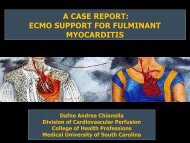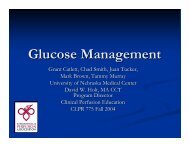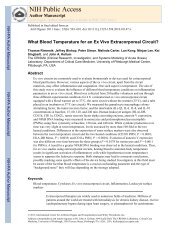PowerPoint Presentation (PDF) - Perfusion.com
PowerPoint Presentation (PDF) - Perfusion.com
PowerPoint Presentation (PDF) - Perfusion.com
You also want an ePaper? Increase the reach of your titles
YUMPU automatically turns print PDFs into web optimized ePapers that Google loves.
Department of Pathology,<br />
University of Pittsburgh<br />
Does the RBC storage lesion<br />
matter clinically?<br />
Mark Yazer, MD FRCPC
History of RBC storage<br />
• RBCs were initially stored in citrate at room temperature<br />
• Lasted for only a few days<br />
• In the refrigerator they lasted a bit longer<br />
• In the 1940s glucose was added to the RBCs along with citrate<br />
• 21 day expiration<br />
• In North America RBCs are stored in an adenine rich solution for<br />
up to 42 days
The RBC storage lesion<br />
• As RBCs are stored ex vivo they undergo changes<br />
• These include metabolic and shape changes<br />
• Collectively they are known as the storage lesion
How has the RBC storage lesion been studied?<br />
• 3 types of studies evaluating the RBC storage lesion:<br />
• In vitro, biochemical studies<br />
• In vivo, physiological studies without patient<br />
out<strong>com</strong>es<br />
• Retrospective studies of recipient morbidity and<br />
mortality
How has the RBC storage lesion been studied?<br />
• 3 types of studies evaluating the RBC storage lesion:<br />
• In vitro, biochemical studies<br />
‣ Have elucidated the changes in RBC<br />
metabolism and shape during storage<br />
• In vivo, physiological studies without patient<br />
out<strong>com</strong>es<br />
• Retrospective studies of morbidity and mortality
Decrease in 2,3-DPG<br />
• Hb is a tetramer of 4 proteins each containing a heme unit<br />
• 2,3-diphosphoglycerate is a small molecule that binds into the<br />
Hb tetramer<br />
• 2,3-DPG promotes oxygen offloading in hypoxic areas
Decrease in 2,3-DPG<br />
• 2,3-DPG is depleted during storage<br />
• Its decline is mirrored by an increase in Hb oxygen<br />
saturation<br />
• 2,3-DPG is restored 24-72 hours after transfusion<br />
Bennett-Guerrero et al. PNAS, 2007
k on , oxygen binding rate constant, increases after day 14<br />
Gelderman MP et al. Transfusion Medicine in press
k off , oxygen off loading rate constant, does not change<br />
Gelderman MP et al. Transfusion Medicine in press
RBC shape change<br />
• Stored RBCs undergo shape changes<br />
• Normal morphology is maintained until severe drops in<br />
intracellular ATP occur<br />
Red Cell Shape, Bessis M, Weed RI, Leblond PF, 1973
Other biochemical/membrane changes<br />
• Altered NO metabolism<br />
• Increased aggregability<br />
• Increased adhesion to endothelial cells<br />
• Increases in RBC membrane sublethal injury (MFI)<br />
• Membrane vesiculation<br />
• Paralysis of Na/K ATPase<br />
• Reduced membrane deformability<br />
• Altered membrane protein/lipid <strong>com</strong>position
Conclusions on in vitro, biochemical studies<br />
• These are essential studies to understand the basic<br />
changes in the RBCs during storage<br />
• They define the biological elements of the storage<br />
lesion<br />
• Major limitation:<br />
• Should be interpreted only as defining a biological<br />
constellation of changes to RBCs during storage<br />
• Not intended to predict recipient out<strong>com</strong>es to<br />
transfusion
How has the RBC storage lesion been studied?<br />
• 3 types of studies evaluating the RBC storage lesion:<br />
• In vitro, biochemical studies<br />
• In vivo, physiological studies without patient<br />
out<strong>com</strong>es<br />
‣ Evaluate changes in recipient’s physiological<br />
parameters only<br />
• Retrospective studies of morbidity and mortality
Analysis of tissue oxygenation<br />
• Study evaluated changes in tissue oxygenation after transfusion<br />
• Used Near Infrared Spectroscopy with sensor mounted on<br />
thumb<br />
• Does receipt of RBCs ≥21 days affect oxygenation?<br />
Kiraly LN et al. J Trauma 2009
Analysis of tissue oxygenation<br />
• Patient undergoing active resuscitation, sepsis, requiring<br />
vasopressor support excluded<br />
60<br />
minutes<br />
Transfusion<br />
Baseline<br />
Transfusion starts<br />
Transfusion<br />
4 hours posttransfusion<br />
Endtransfusion<br />
-60<br />
0 100 160<br />
60
Analysis of tissue oxygenation<br />
•Small numbers of patients in this study<br />
• Limited demographics<br />
• How many units were transfused in the 2 groups?<br />
Ages of the transfused RBCs?<br />
Kiraly LN et al. J Trauma 2009
Analysis of tissue oxygenation<br />
• Significant decrease in StO 2 during transfusion period in Old<br />
group<br />
• “This drop trended toward significance after the end of<br />
transfusion (p=0.06)”<br />
Baseline<br />
Transfusion<br />
Patient<br />
status?<br />
4 hours post transfusion<br />
Kiraly LN et al. J Trauma 2009
Analysis of tissue oxygenation<br />
• Age of the single oldest unit of RBCs<br />
• R = 0.5 (p < 0.05)<br />
• A modest correlation, at best<br />
Kiraly LN et al. J Trauma 2009
Conclusions<br />
• No clinical out<strong>com</strong>es reported<br />
• Did the apparently transient decrease in StO 2 impact<br />
morbidity or mortality?<br />
• Does StO 2 in the thumb reflect that in other tissues?<br />
• Limited demographic/RBC data reported<br />
• Although this study involved patients, its findings are no<br />
more clinically relevant than in vitro studies
Conclusions on in vitro, physiological studies<br />
• Like in vitro biochemical studies, these define<br />
physiological parameters in actual recipients<br />
• Involve actual human/primate recipients<br />
• Major limitation:<br />
• If they do not measure clinical out<strong>com</strong>es, the data<br />
cannot be used to predict out<strong>com</strong>es in actual recipients<br />
• Contribute towards the basic science knowledge base of<br />
the storage lesion, not its clinical effects (if any)
Schieẞ ein Tor…
How has the RBC storage lesion been studied?<br />
• 3 types of studies evaluating the RBC storage lesion:<br />
• In vitro, biochemical studies<br />
• In vivo, physiological studies without patient<br />
out<strong>com</strong>es<br />
• Retrospective studies of morbidity and mortality<br />
‣ Review recipient’s charts after transfusion for<br />
morbidity and mortality information
Retrospective studies - Pro<br />
• Retrospective studies are easier to get past IRB than RCT<br />
• Data already exists, it just needs to be mined<br />
• Can feature enormous numbers of patients as consent is<br />
not usually required<br />
• Good for generating hypotheses
Retrospective studies - Con<br />
• If <strong>com</strong>paring an intervention, must ensure 2 groups are<br />
identical<br />
• Otherwise results could be due to confounders<br />
• Very hard to account for confounding variables<br />
• Demographics of groups must be presented<br />
• Often require <strong>com</strong>plicated statistics to show a result
Remember…<br />
• # RBCs transfused is highly correlated to age of RBCs<br />
• Sicker patients receive more RBC transfusions<br />
• Thus sicker patients tend to get older RBCs<br />
• Sicker patients have worse out<strong>com</strong>es<br />
• So is an unfavorable out<strong>com</strong>e due to the patients’ natural<br />
history or receipt of older RBCs?
Koch et al. NEJM 2008<br />
Large, retrospective study on age of RBCs in cardiac surgery<br />
patients<br />
• A large study of CABG or valve surgery patients was performed<br />
• RBC age: ≤ 14 days vs. >14 days<br />
• Patients who received a mix of “fresher” and “older” blood were<br />
excluded<br />
• Composite endpoint:
Koch et al. NEJM 2008<br />
Both groups of patients received median 2 RBC units<br />
• 2872 patients in Newer group, 3130 patients in Older group<br />
• Same median number of RBCs transfused: 2<br />
• Newer RBCs were median 11 days, Older RBCs were 20 days<br />
50%
Koch et al. NEJM 2008<br />
Matching of cohorts was not perfect<br />
• NYHA grades differed significantly between the 2 groups<br />
• Significant differences in ABO groups of RBCs
Out<strong>com</strong>e measures were broad and not easily explicable by RBC<br />
transfusion<br />
Dichotomous variable<br />
Koch et al. NEJM 2008
Koch et al. NEJM 2008<br />
Greater mortality amongst recipients of median 2 RBC units<br />
92.6%<br />
92.6%<br />
Increased LV dysfunction<br />
Increased MV regurgitation<br />
89.0% (p
Conclusions<br />
• Mortality end points are very broad<br />
• Actual causes of death not presented<br />
• Death caused by being run over by a bus after receiving RBCs<br />
would appear as related to the transfusion<br />
• Authors offer no specific mechanism linking “older” blood to<br />
negative out<strong>com</strong>es<br />
• Authors do not propose changing the current RBC issuing practice<br />
• Large study, hypothesis generator
Another retrospective study of mortality and the storage lesion<br />
• The largest retrospective study to date<br />
• Analyzed database containing Swedish and Danish<br />
transfusion recipients from 1995-2002<br />
• Inclusion criteria:<br />
• Ages 15 – 90<br />
• No tx 2 years prior to index transfusion<br />
• Exclusion criteria:<br />
• Receipt of autologous RBCs<br />
• Receipt of ABO non-identical units<br />
• Receipt of RBCs of unknown ABO group/age<br />
Edgren G et al. Transfusion 2010
Another retrospective study of mortality and the storage lesion<br />
• Patients were generally surgery or trauma patients<br />
• Divided into 4 groups based on RBC age<br />
• 0-9 days old<br />
• 10-19 days old<br />
• 20-29 days old<br />
• 20-42 days old<br />
• Mixed<br />
• The reference group of recipients was the 10-19 day<br />
old RBC group<br />
Edgren G et al. Transfusion 2010
Mortality assessed over 2 periods<br />
• Short term survival (404,959 tx, 387,130 patients):<br />
• Transfused on day 1 and followed for 7 days<br />
• Long term survival (380,549 tx, 364,037 patients):<br />
• Transfused between days 1-7 and followed from day 8<br />
through 2 years<br />
• Surveillance also terminated upon death, emigration<br />
and end of study period (31 Dec 2002)<br />
Edgren G et al. Transfusion 2010
Koch et al.<br />
10 km
Scandinavian study<br />
Cleveland<br />
650 km
Patient demographics<br />
• The recipients were well matched between the 5<br />
groups<br />
• Matched for age, gender, ABO, LOS, number of RBCs,<br />
indications for transfusion<br />
• Median storage ages:<br />
• 0-9 days: 7 (5-8)<br />
• 10-19 days: 14 (12-16)<br />
• 20-29 days: 23 (21-26)<br />
• 30-42 days: 34 (31-37)<br />
• Mixed: 17 (11-22)<br />
Edgren G et al. Transfusion 2010
Mortality out<strong>com</strong>es<br />
• Mortality not increased amongst recipients of oldest RBCs who<br />
were ≥70 years, or CABG, or ECMO<br />
• Leukoreduction did not affect survival<br />
Edgren G et al. Transfusion 2010
Causes of mortality<br />
• Compared recipients of 30-42 days old to 10-19 days old<br />
• No single cause of death predominated<br />
Day 1-7 Day 8-730<br />
Edgren G et al. Transfusion 2010
Chicken and egg…<br />
• The number of 30-42 day old units received did not influence<br />
mortality<br />
?<br />
Edgren G et al. Transfusion 2010; Middelburg RA et al. Transfusion 2010
Another retrospective study of mortality and the storage lesion<br />
• The largest, by far, study to date<br />
• Well matched patient demographics<br />
• Was the 5% increase in mortality causally related to<br />
RBC transfusion?<br />
• 5% increase in mortality surprisingly stable over time<br />
• No single cause of death predominated<br />
• No dose response relationship<br />
• How to explain the result in the mixed group?<br />
• Seems related to underlying disease, not RBC<br />
• Would have been nice to have seen morbidity data
Conclusions on retrospective studies<br />
• Hypothesis generating<br />
• Major limitation:<br />
• Lack of randomization<br />
• Various types of confounding<br />
• Inadequate matching of groups can bias results<br />
• NOT hypothesis proving
RECESS study<br />
2 prospective randomized trials are <strong>com</strong>ing!<br />
• Cardiac surgery patients<br />
• ≤ 10 day RBC vs. ≥ 21 day old LR RBC<br />
• Primary out<strong>com</strong>e:Multiple organ dysfunction score on POD 7<br />
• ~1832 patients<br />
ABLE study<br />
• ICU patients<br />
• RBC storage length ≤ 7 days vs. standard issue LR RBCs<br />
• Primary out<strong>com</strong>e: 90-day all cause mortality<br />
• 2510 patients
• The storage lesion is real!<br />
Conclusions<br />
• The clinical data has by no means proven that its effects<br />
are detrimental to recipients<br />
• What should be done about how the BB currently issues<br />
RBCs?<br />
אין דבר<br />
33ff.<strong>com</strong>/flags

















